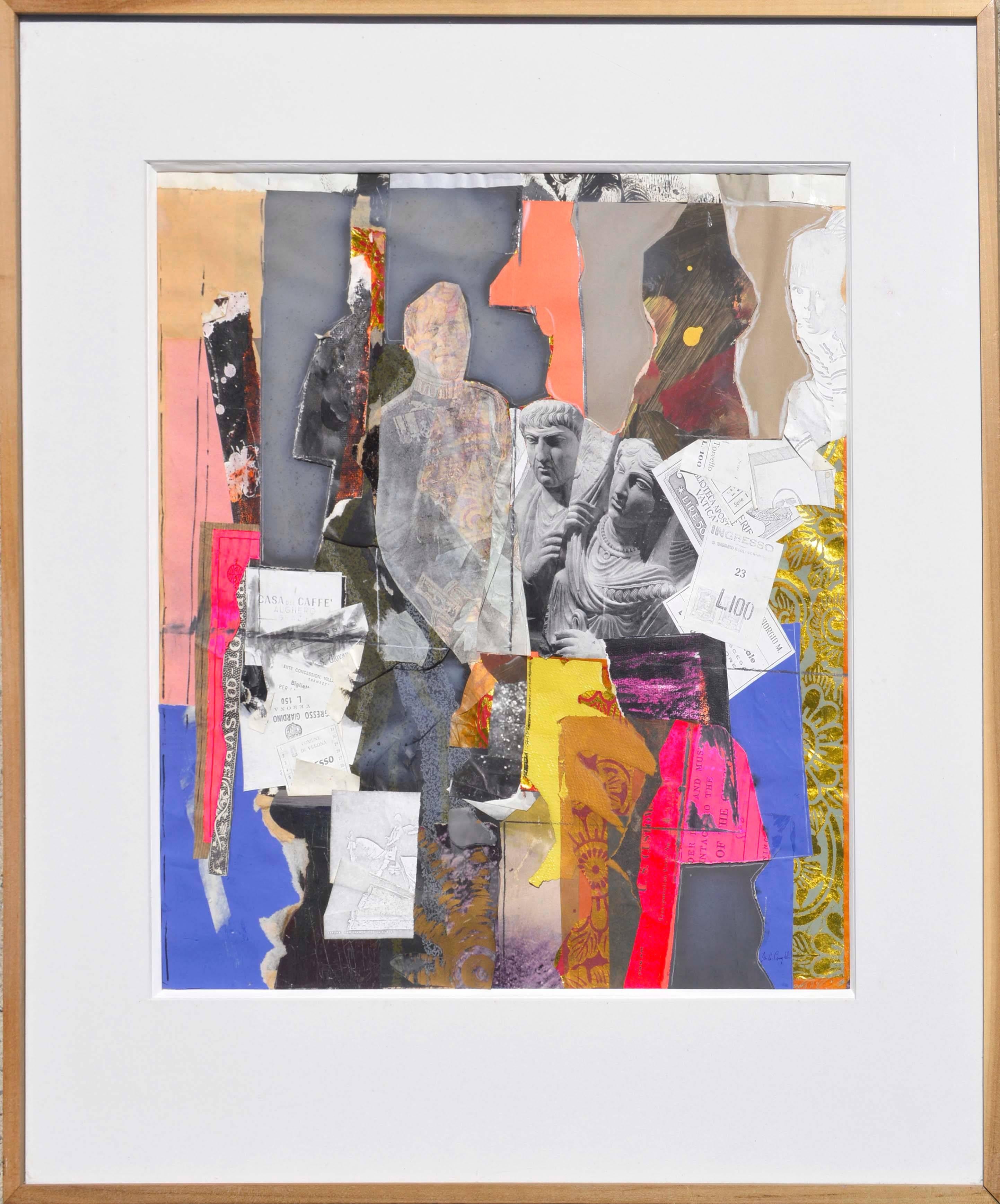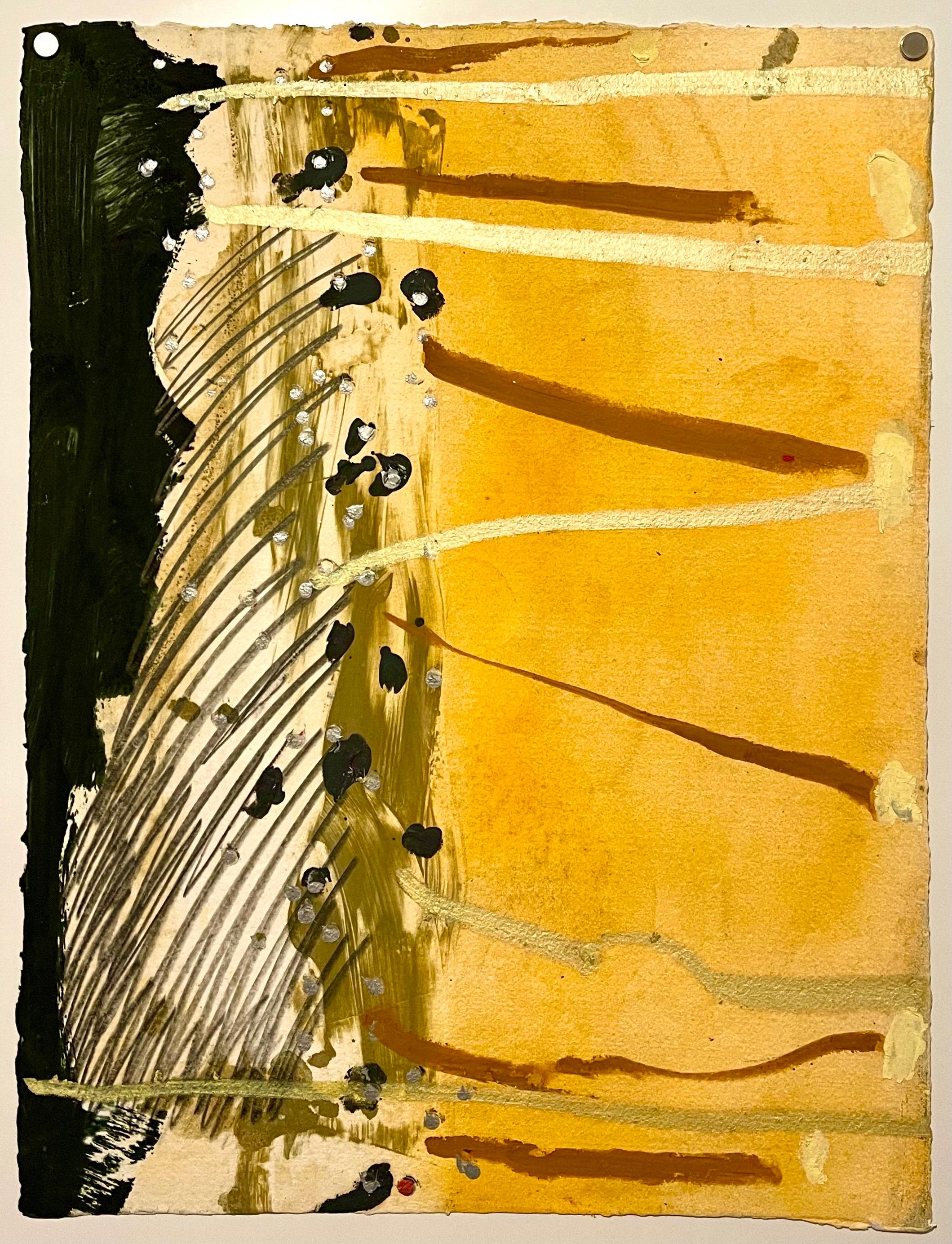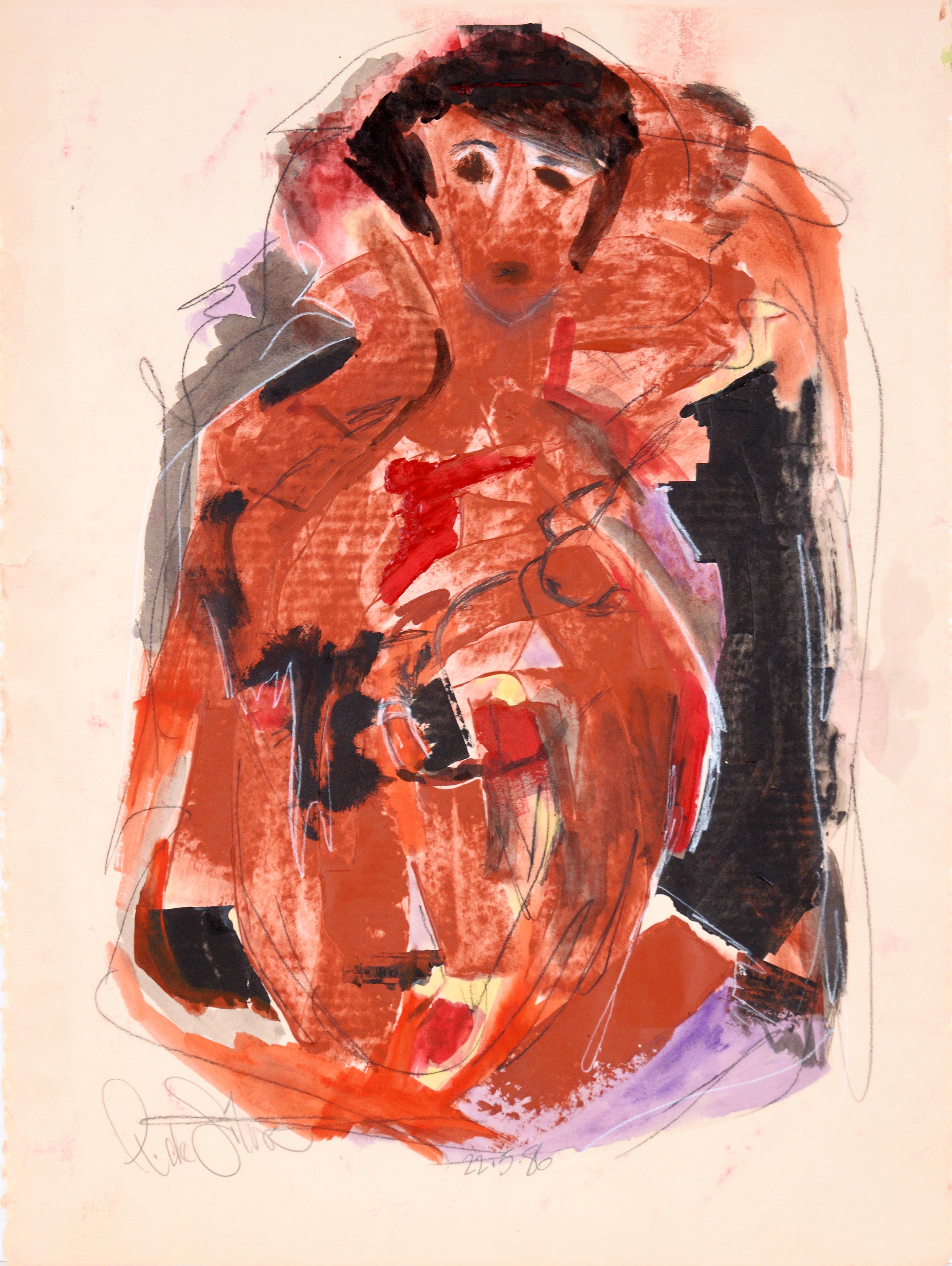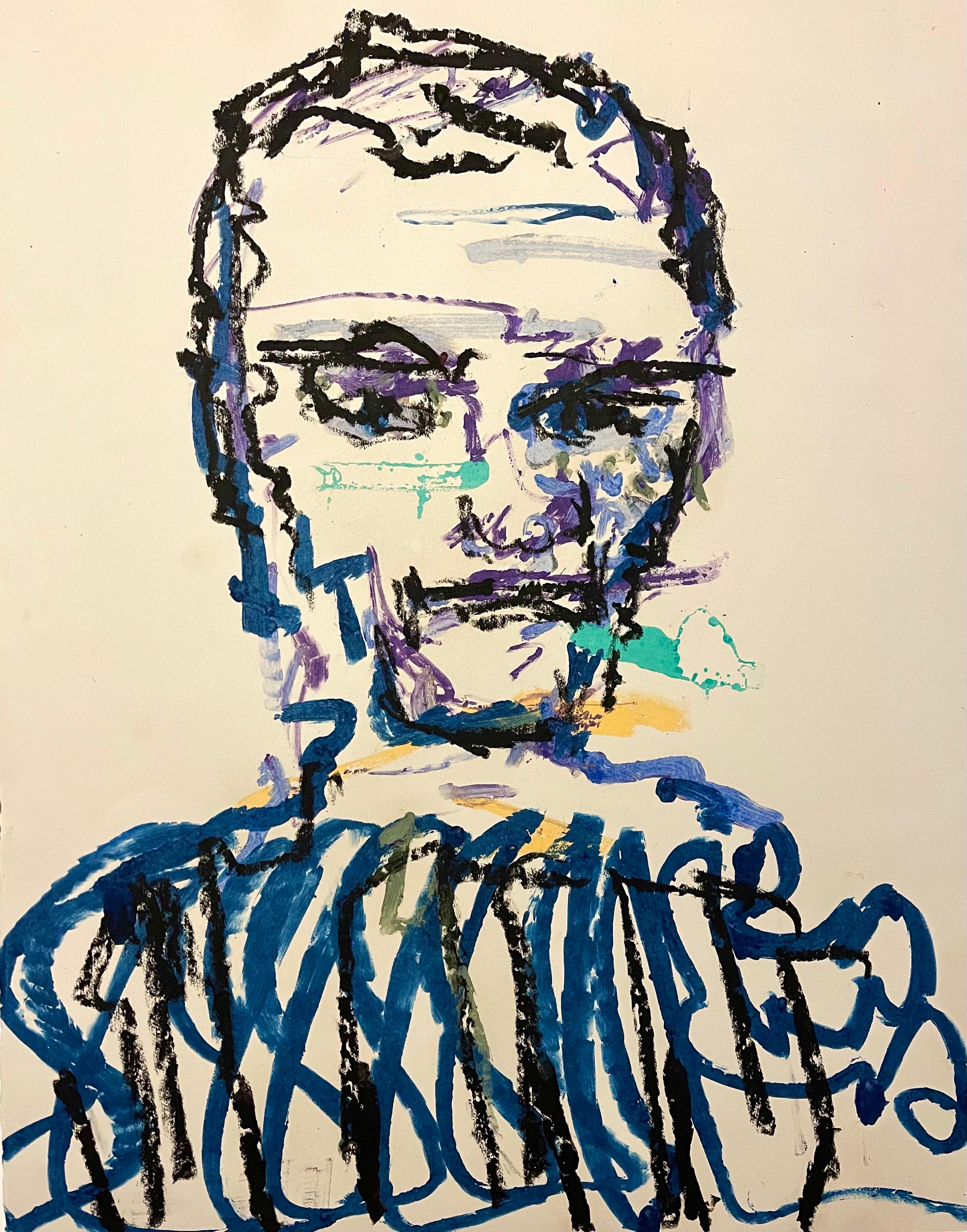Items Similar to Mid century Modern 1960s Abstract Expressionist painting, renowned artist Signed
Want more images or videos?
Request additional images or videos from the seller
1 of 10
Jack WolfeMid century Modern 1960s Abstract Expressionist painting, renowned artist Signed1965
1965
About the Item
Jack Wolfe
Untitled, 1965
Acrylic and collage on board
Hand signed on the front
Frame included: held in original vintage frame with original gallery label
Unique
Provenance: Parker Street 470 Gallery, Boston, Mass (with label verso)
Excellent abstract expressionist mixed media work.
Measurements:
Image:
17" x 24"
Framed:
24" x 28" x 1"
From Wiki:
Jack Wolfe (14 January 1924 – 18 November 2007) was a 20th-century American painter most known for his abstract art, portraiture, and political paintings. Jack Wolfe was born in Omaha, Nebraska on January 14, 1924, to Blanche and Everett L. Wolfe. Soon after his birth, his family moved to Brockton, MA. At 18, Wolfe had an interest in commercial illustration, which he pursued at the Rhode Island School of Design (RISD). However, upon matriculating at RISD in 1942, he developed an interest in fine art and painting inspired by an exhibition of modern French art. He described this change of direction, explaining that, "One day, for the first time, I saw an exhibition of modern French art. It was like being struck by lightning." He became particularly interested in the work of a number of European modernists, including Rouault, Cézanne, Braque, Modigliani, and Picasso.[1] Following his time at RISD, he pursued a Master’s in Fine Arts degree at the Museum of Fine Arts School in Boston, MA. At the Museum School, Wolfe studied under the renowned Expressionist Karl Zerbe, a German-born artist who was the Museum School's most influential and vital teacher until 1953.[2] After graduating from the Museum School, Wolfe was represented by the Margaret Brown Gallery in Boston, which also represented many other cutting edge Moderns that defied the more conservative tastes of New England collectors at the time, including György Kepes, Congur Metcalf, and Alexander Calder.[3]
Career and Museum Representation
Jack Wolfe's painting "Robin's Rock" 1962, 72" x 72"
Jack Wolfe's artwork received early recognition from a number of organizations and was consistently featured in influential exhibitions, including the 1955 Carnegie International at the Carnegie Institute in Pittsburgh, PA, the American Federation of Art's traveling exhibition New Talent in the USA in 1956-57, the Whitney Museum’s Young America exhibition in 1957,[4] the Boston Institute of Contemporary Art's Selection exhibition in 1957,[5] and both the Whitney Museum’s 1958 Annual exhibition and its Forty Artists Under Forty show in 1962-63.[6] In 1959, his widely acclaimed Portrait of Abraham Lincoln toured Europe in a show circulated by the Institute of Contemporary Art, Boston. In addition, his painting Crucifixion was chosen by the United States Information Agency to be exhibited across Europe, including being shown at the Salzburg Biennial in Austria in 1958.[7] Crucifixion was also exhibited at the Whitney Museum and subsequently displayed in the National Cathedral in Washington, DC, in 1958.[8] In 1966-67, his work was selected for Art for Embassies by the U.S. State Department.[9] He received the first annual Margaret Brown Memorial Award for high achievement by a New England Artist from the Institute of Contemporary Art, Boston, in 1958.[10]
With his future as one of the great artists of his time laid out neatly before him, Wolfe moved to New York in the early 1950s, which was then the postwar epicenter of the art world and in the midst of experiencing the first real revolution in American Art, now known as Abstract Expressionism.[11] However, almost immediately upon his arrival, he became disenfranchised with the overtly commercial nature of the art scene there, spurning fame and security in an unwillingness to bend his creative vision to the expectations of others.[12] After four short months, he left New York, returned to Massachusetts where he bought property in Stoughton, cleared the land, and built both his home and studio with his own two hands. He would go on to live and paint there, extensively exhibiting and garnering constant critical acclaim.[13]
Wolfe became one of the earliest artists championed by the deCordova Museum in Lincoln, MA and the Institute of Contemporary Art in Boston. He was awarded a traveling scholarship in 1958,[6] which allowed him to set up studio in San Miguel de Allende, Mexico and then in San Francisco, California.[14] Upon his return in 1959, the deCordova museum hosted Wolfe’s third solo exhibition, featuring work made during his time in California.
Following his travels, Wolfe returned to Massachusetts, where he supported himself both through his artwork and with several different jobs, including working as a truck driver, carpenter, and laborer. He even designed silverware chests and at one point worked as a restorer alongside artist Gustav Klimann.[15] In a review of his first solo show, a critic wrote: "It seems odd that such sensitive work is done by a painter who must spend part time driving a truck."[16] Wolfe began to become associated with a group of artists known as the Boston Expressionists.[17] His work combined abstract expressionist, cubist and hard-edge techniques,[18][19] often exploring geometry and depth with a highly saturated and unusual color palette.[20][21] In addition to abstract works, he was equally interested in portraiture, and painted many portraits from life.[22] His portraiture was shown in a well-received joint exhibition with Elaine de Kooning in 1965.[18]
Legacy
While working from his studio in Stoughton, MA, Wolfe continued to participate in many exhibitions, with his abstract art, political paintings, and portraits featured in museums across the United States.[23] In 1999, his work was featured in an exhibition at the Danforth Museum, titled "Jack Wolfe - Outside the Mainstream". In addition, his large scale political paintings were displayed in a 2005 show titled "Jack Wolfe - Major Political Work from Six Decades of Paintings" at the University of Massachusetts, Boston. His estate is represented by CK Contemporary in San Francisco, CA.
Wolfe's art continues to be represented within private and museum collections, including the Whitney Museum of American Art, the Boston Museum of Fine Arts, the Phoenix Art Museum, the Rose Art Museum, the deCordova Museum, the Worcester Art Museum, and the Addison Gallery of American Art.[24][25] His portraiture is represented in the collections of many Boston-area institutions, including Boston University, Harvard University, Tufts University, and the University of Massachusetts, Boston. He died of cancer, in 2007, at the age of 83.
- Creator:Jack Wolfe (1924 - 2007, American)
- Creation Year:1965
- Dimensions:Height: 24 in (60.96 cm)Width: 28 in (71.12 cm)Depth: 1 in (2.54 cm)
- Medium:
- Movement & Style:
- Period:
- Condition:Ships in original vintage frame.
- Gallery Location:New York, NY
- Reference Number:1stDibs: LU1745213963532
About the Seller
5.0
Platinum Seller
These expertly vetted sellers are 1stDibs' most experienced sellers and are rated highest by our customers.
Established in 2007
1stDibs seller since 2022
299 sales on 1stDibs
Typical response time: 1 hour
- ShippingRetrieving quote...Ships From: New York, NY
- Return PolicyA return for this item may be initiated within 1 day of delivery.
More From This SellerView All
- In Real Time, unique signed Abstract Expressionist painting compared to MatisseBy Steven SormanLocated in New York, NYSteven Sorman In Real Time, 2003 Acrylic, gouache, gel medium, oil and beeswax collage painting on paper 48 × 34 inches Signed and dated 2003; The frame also bears the original label...Category
Early 2000s Abstract Expressionist Abstract Paintings
MaterialsMixed Media, Oil, Acrylic, Gouache, Gel Pen, Graphite
- Judy Pfaff Original abstract hand Signed mixed media 3D collage, Unique, FramedBy Judy PfaffLocated in New York, NYJudy Pfaff original signed paper and mixed media 3D collage, ca. 1986 Mixed media 3:D paper collage with vinyl signed and inscribed "To Connie Love Judy Pfaff" in marker on the front...Category
1980s Abstract Expressionist Mixed Media
MaterialsPaper, Mixed Media, Vinyl, Laid Paper, Permanent Marker
- Signed Abstraction by renowned Los Angeles artist & Rauschenberg protege UniqueBy Laddie John DillLocated in New York, NYLaddie John Dill Untitled Mixed Media painting, 2011 Cement, polymer, wood, mixed media on board 12 × 18 × 1 1/2 inches Signed and dated on the back Unique work This exquisite unique...Category
2010s Abstract Expressionist Abstract Paintings
MaterialsWood, Acrylic Polymer, Mixed Media, Permanent Marker
- Untitled Mid Century Modern abstract sculptural drawingBy Dorothy DehnerLocated in New York, NYDorothy Dehner Untitled Mid Century Modern abstract sculptural drawing, 1955 Marker and graphite on paper Signed and dated by Dorothy Dehner in black felt tip pen on the front Frame ...Category
1950s Abstract Expressionist Abstract Drawings and Watercolors
MaterialsPermanent Marker, Graphite, Mixed Media
- Ammersee #2By Walter Darby BannardLocated in New York, NYWalter Darby Bannard Ammersee #2, 1975 Watercolor and acrylic painting on paper Signed, titled and dated lower recto This is a unique work Frame included: elegantly floated and frame...Category
1970s Abstract Expressionist Abstract Drawings and Watercolors
MaterialsInk, Mixed Media, Acrylic, Watercolor, Graphite
- Rock Candy Mountain (unique, signed Abstract Expressionist painting)By Ben WilsonLocated in New York, NYBen Wilson Rock Candy Mountain, ca. 1970 Oil on masonite board (Hand Signed, titled and dated) Hand signed, titled and dated by Ben Wilson on the back Frame Included: held in artist's original vintage 1970 wood frame This stunning painting with candy colors is done by the second generation Abstract Expressionist artist Ben Wilson - one of the youngest artists to be given a show at prestigious ACA Gallery in 1940. In 2017, he was the subject of a career retrospective at the George Segal Gallery at Montclair State University from September 6 to November 4 and it was accompanied by a catalogue. Measurements: Frame: 23.5 x 47.5 x 1 inch Artwork: 25 x 49 inches About Ben Wilson: Ben Wilson was born in Philadelphia in 1913 to Jewish parents who had emigrated from Kiev and settled in New York City. He was educated in Manhattan public schools and graduated from City College in 1935. To gain exposure to a wider range of styles, he also studied at the National Academy of Design and at the Educational Alliance. Admired by critics throughout his long career, Wilson was singled out as a “discovery” by the New York Times art critic Edward Alden Jewel even before his first one-man show at the Galerie Neuf in 1946. His paintings of the ’30s and ’40s were expressionistically rendered, often Biblical parables, filled with what he called “the grief of the intolerable” and reflecting an acute awareness of the agony of the time, from the Holocaust to the Spanish Civil War. A WPA artist who identified strongly with the plight of the Jews in Europe, he relentlessly explored themes of war, torment, and futility in his early decades of painting. When times changed and social pressures subsided, Wilson’s mood lifted. He spent 1952-54 in Paris working at the Academie Julien. During the ’50s his involvement with specific imagery persisted but became more psychological and mythic in orientation. Influenced by Cubism, he created a vocabulary of interlocking shapes and bold, sweeping gestures that served as a transition between his early figurative expressionism and his later abstract constructivist concerns. Towards the end of the decade Wilson reached a crossroads, moving towards abstraction and searching for what he called “a scaffolding under the externals.” By 1960, influenced by the Russian Constructivists, Mondrian, and Abstract Expressionism, Wilson turned to abstraction. Reexamining the basic elements of painting, he evolved his own personal vocabulary and structure, fusing the cerebral and the emotive. He became increasingly experimental, using house paint, sand, and other unorthodox materials in paintings that he worked from all directions, dripping, spraying, stenciling, and collaging. He employed elements of disjunction, repetitions of geometric motifs, linear networks, and complex overlays to create the transparent, multi-layer development of space that characterizes his later paintings. A consummate draftsman, Wilson filled notebook after notebook with drawings that he amplified in his paintings. Eschewing popular movements, Wilson was always one to pursue a personal aesthetic. Despite more than 30 one-man shows and 50 years of teaching, he increasingly withdrew from the gallery scene but continued to paint daily until his death at age 88 in 2001 in Blairstown, New Jersey, where he and his sculptor wife Evelyn Wilson...Category
1970s Abstract Expressionist Abstract Paintings
MaterialsPermanent Marker, Oil, Masonite
You May Also Like
- Mid Century Antica Roma Figurative Abstract CollageBy James CoughlinLocated in Soquel, CAStunning mid century mixed media collage of Roman travel items and photos by James A. Couglin, a Berkeley Abstract Expressionist (American, 1929-1979), c.1966. Painted during his Par...Category
1960s Abstract Expressionist Abstract Paintings
MaterialsPaper, Acrylic, Permanent Marker, Magazine Paper
- Stanley Boxer Mixed Media Abstract Expressionist Painting on Paper, GoldBy Stanley BoxerLocated in Surfside, FLAbstract, 1987 Hand signed and dated verso Not sure of technique. this might be a monotype or monoprint with hand painting. The handmade paper is cut somewhat irregularly as per the artists intentions. Stanley Boxer (1926-May 8, 2000) was an American abstract expressionist artist best known for thickly painted abstract works of art. He was also an accomplished sculptor and printmaker. He received awards from the Guggenheim Fellowship and the National Endowment for the Arts. Boxer was born in New York City, and began his formal education after World War II, when he left the Navy and studied at the Art Students League of New York. He drew, painted, made prints, and sculpted. His work was recognized by art critic Clement Greenberg, who categorized him as a color field painter, A group that included Barnett Newman, Clyfford Still, and Mark Rothko and was a form of Abstract Expressionism and later included Helen Frankenthaler, Ad Reinhardt, Kenneth Noland, Gene Davis, Jules Olitski, Raymond Parker and Morris Louis. Boxer himself was adamant in rejecting this stylistic label. Over the years, he remained loyal to the materially dense abstract mode on which his reputation rested.. Art critic Grace Glueck wrote "Never part of a movement or trend, though obviously steeped in the language of Modernism, the abstract painter Stanley Boxer was a superb manipulator of surfaces, intensely bonding texture and color." In 1953 Boxer had his first solo exhibition of paintings in New York City, and showed regularly thereafter until his death. His paintings and sculpture were represented in New York City during the late 1960s through 1974 by the Tibor de Nagy Gallery, then by the André Emmerich Gallery from 1975 until 1993, and finally by Salander-O'Reilly Galleries until its demise in 2007. Richard Waller...Category
1980s Abstract Expressionist Mixed Media
MaterialsArchival Paper, Acrylic, Gouache
- Alan Partridge's Bleeding Heart - Abstract ExpressionismLocated in Soquel, CAAlan Partridge's Bleeding Heart - Abstract Expressionism Double-sided artwork: Backside abstract expressionism represents a dancer in a coral dress A subdued abstract painting in r...Category
21st Century and Contemporary Abstract Expressionist Abstract Paintings
MaterialsPaper, Acrylic, Charcoal, Gouache
- Man on Wire - Abstract Expressionism "The Great Wallendas"Located in Soquel, CAMan on Wire - Abstract Expressionism A vibrant abstract painting in intense poppy-red depicting a man dressed in black tie walking a tightrope with an umbrella, by California-based artist, Ricardo de Silva...Category
21st Century and Contemporary Abstract Expressionist Abstract Paintings
MaterialsPaper, Charcoal, Acrylic, Gouache
- Stanley Boxer Mixed Media Abstract Expressionist Portrait Painting on PaperBy Stanley BoxerLocated in Surfside, FLAbstract, 1987 Hand signed and dated verso Not sure of technique. this might be a monotype or monoprint with hand painting. This might be a self portrait. Stanley Boxer (1926-May 8, 2000) was an American abstract expressionist artist best known for thickly painted abstract works of art. He was also an accomplished sculptor and printmaker. He received awards from the Guggenheim Fellowship and the National Endowment for the Arts. Boxer was born in New York City, and began his formal education after World War II, when he left the Navy and studied at the Art Students League of New York. He drew, painted, made prints, and sculpted. His work was recognized by art critic Clement Greenberg, who categorized him as a color field painter, A group that included Barnett Newman, Clyfford Still, and Mark Rothko and was a form of Abstract Expressionism and later included Helen Frankenthaler, Ad Reinhardt, Kenneth Noland, Gene Davis, Jules Olitski, Raymond Parker and Morris Louis. Boxer himself was adamant in rejecting this stylistic label. Over the years, he remained loyal to the materially dense abstract mode on which his reputation rested.. Art critic Grace Glueck wrote "Never part of a movement or trend, though obviously steeped in the language of Modernism, the abstract painter Stanley Boxer was a superb manipulator of surfaces, intensely bonding texture and color." In 1953 Boxer had his first solo exhibition of paintings in New York City, and showed regularly thereafter until his death. His paintings and sculpture were represented in New York City during the late 1960s through 1974 by the Tibor de Nagy Gallery, then by the André Emmerich Gallery from 1975 until 1993, and finally by Salander-O'Reilly Galleries until its demise in 2007. Richard Waller...Category
1980s Abstract Expressionist Mixed Media
MaterialsAcrylic, Gouache, Archival Paper
- Flight. Abstract light composition. 2020. Paper, mixed media, 70x49 cmLocated in Riga, LVMāris Abiļevs (born 23 April 1956 in Kazakhstan) is a Latvian graphic artist and printer, brother of graphic artist Andris Abiļevs. He works in etching, lithography and various mixed...Category
2010s Abstract Abstract Paintings
MaterialsPaper, Mixed Media, Acrylic, Permanent Marker
Recently Viewed
View AllMore Ways To Browse
Mid Century Modern Abstract Art
Abstract Signed Midcentury
1960s Modern Painting
Selection Of Modern Art
Picasso Signed Painting
Abstract Mid Century Modern Paintings
Midcentury Modern Abstract Paintings
Vintage Mid Century Modern Abstract Paintings
Europe Mid Century Paintings
Vintage Midcentury Modern Abstract Paintings
Mid Century Abstract Large
Original Abstract Mid Century Modern
Abstract Mid Century Vintage Art
Mid Century Abstract Art Vintage
Large Mid Century Modern Paintings
Mid Century Modern Paintings 1960s
Boston Vintage Design
Postwar Modern





